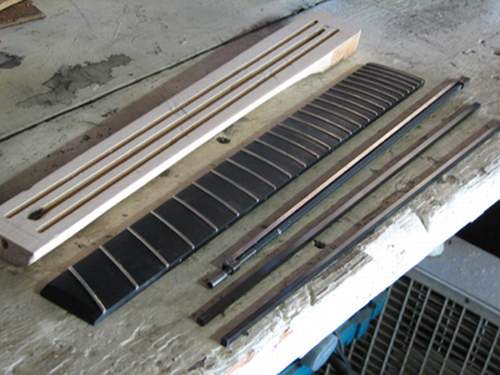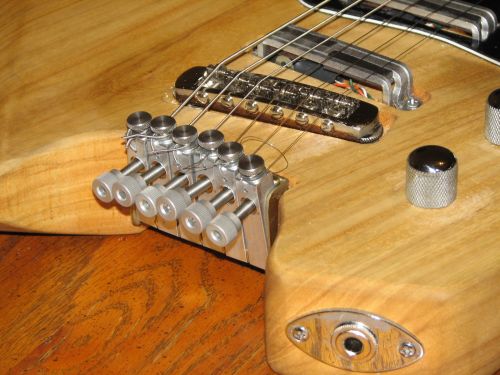Eric Olds Klein Guitar Project – Part 1
Classic guitar designs are often the jumping off points for guitar builds and the Klein electric guitar is no exception. As a classic in its own right, we’ve seen the basic shape used as a jumping off point several times before including builds by Mats Erikson, PJ Doland as well as my own first project guitar. In every case, each of these has come to life with its own twists and turns over the original.Enter Eric Olds who shares his version of a Klein based electric guitar. His project includes a fanned fret neck, a home made headpiece and a very well documented headless tuning system of his own design.
These conceptual images show front and back views of the instrument:


Eric started by importing a JPEG of a Klein guitar into the 3D cad program Solid Works. He then generated several plan drawings to include the guitar body, the fanned fret fingerboard, the neck’s construction and his tuning tail piece. This extra effort is another guitar builder’s gain because Eric has generously made these available to Building the Ergonomic Guitar readers.
And so, here is the first of the plans in Adobe Acrobat format (PDF) – a two page overview of the instrument which includes estimated build costs. Right click on the link below and choose to save:
Klein Guitar Copy Overview.pdf – 583 KB
Fanned Fret Neck
The maple neck has a single truss rod with graphite rod reinforcements on either side making for a good stiff neck:

So far, fanned frets are pretty easy to play – most of the time you don’t really notice a difference. Some of the low bar chords you have to be a bit more careful with though. (F major, B…) I didn’t go too extreme, the scale length is 25.75 on the low E and 24.25 on the high. (This allowed me to use an existing bridge.) I’m not convinced that they are more comfortable to play (yet…) but they are certainly not any hindrance. With the more even string tension, I’m using heavier strings than I usually do (.013 vs .011) and I’m finding them as easy to play as the lighter strings on my other guitars.
Eric Olds Klein Guitar Project – Part 2
In part 2 of the Eric Olds Klein Electric Guitar Project, we take a look at the completed guitar and Eric’s headless tuner system. Also included are download links for plans to the Klein based guitar body and the tuning tailpiece.The Guitar Body Plan
Eric generated full scale plans of the front and back of the guitar body and very generously made these available in Adobe Acrobat format for our readers. Here’s a preview of page 1 of the plan:

Klein Electric Guitar Copy Plan.pdf – 366 KB
The Finished Guitar
The finished instrument features a primavera guitar body, a fanned fret maple neck and a fixed headless tuner solution of Eric’s design:

The Tuning Tailpiece
Eric’s tuner solution takes a number of off-the-shelf parts and transforms them into a tuning tailpiece or tailstop. Combining a Schaller roller bridge and a headpiece of extruded aluminum angle, it’s effective and lightweight. If you’re willing to forgo a tremolo bridge, the 2.6 oz roller bridge and 6 oz tuning tailpiece are a featherweight combination compared to the almost 1.5 lb Steinberger R-trem bridge.

Tuning Tailstop.pdf – 1.08 MB
Eric’s drawings cover everything you need to know to assemble one of your own and it looks good. I can certainly see myself considering it for a future guitar build.
Many thanks to Eric for sharing his build and his tuning solution!
